
Understanding Carbon Steel ERW Tube Mills A Comprehensive Overview
In the realm of steel manufacturing, Electric Resistance Welded (ERW) tubes have carved a niche due to their efficiency and adaptability. Among various materials used in the production of these tubes, carbon steel stands out for its balance of strength, ductility, and affordability. This article delves into the intricacies of carbon steel ERW tube mills, exploring their technology, applications, and significance in the industrial landscape.
What is an ERW Tube Mill?
An ERW tube mill is a sophisticated industrial setup designed for the production of welded tubes from rolled steel coils. The process begins with feeding flat steel strips into the mill, where they are progressively shaped into a cylindrical form. Electric resistance welding is then applied along the seam of the tube, fusing the edges of the steel together. This method offers several advantages over traditional welding techniques, including higher production speeds, improved weld quality, and reduced material waste.
The Role of Carbon Steel
Carbon steel is a steel alloy primarily made up of iron, with carbon as the primary alloying element. Its chemical composition can vary, influencing properties such as strength, hardness, and ductility. In the context of ERW tubes, carbon steel is favored for several reasons
1. Cost-Effectiveness Compared to its alloyed counterparts, carbon steel is more economical, making it a preferred choice for mass production.
2. Mechanical Properties Carbon steel exhibits excellent mechanical properties, including tensile strength and yield strength, which enhance the durability and load-bearing capacity of the tubes.
3. Versatility The wide range of carbon content allows manufacturers to tailor the properties of the steel according to specific applications—whether for structural use, oil and gas transmission, or automotive components.
The Manufacturing Process
The production of carbon steel ERW tubes involves several key steps
1. Slitting Large coils of flat carbon steel are slit into narrower strips, which will eventually be formed into tubes.

2. Forming The slitted strips are heated and formed into a cylindrical shape using rollers.
3. Welding High-frequency electrical currents are utilized to weld the edges of the tube together. This process ensures a strong bond and uniform seam quality.
4. Sizing The welded tubes are then sized to the desired diameter and wall thickness, often using sizing mills to achieve precision.
5. Finishing Post-welding, the tubes undergo various finishing processes such as cutting, surface treatment, and quality control inspections to ensure they meet industry standards.
Applications of Carbon Steel ERW Tubes
The versatility of carbon steel ERW tubes makes them suitable for a wide range of applications
1. Construction They are commonly used in the construction industry for structural applications, including beams, columns, and scaffolding.
2. Oil and Gas Carbon steel ERW tubes are essential for the transportation of oil and gas, providing a robust solution for pipeline systems.
3. Automotive These tubes are employed in automotive applications, such as chassis components and exhaust systems, offering lightweight yet strong solutions.
4. Manufacturing In manufacturing, ERW tubes can be used for fabricating furniture, machinery parts, and other industrial products.
Conclusion
The carbon steel ERW tube mill is a vital component of the modern steel industry, facilitating the efficient production of high-quality welded tubes. Through the innovative use of technology and materials, these mills play a crucial role in meeting the demands of various sectors, from construction to automotive. As the industry evolves, advancements in manufacturing techniques and material science will likely continue to enhance the capabilities of carbon steel ERW tube mills, ensuring they remain at the forefront of the steel manufacturing landscape. Understanding these processes and applications not only highlights the importance of carbon steel in today’s economy but also offers insight into the future of manufacturing practices.